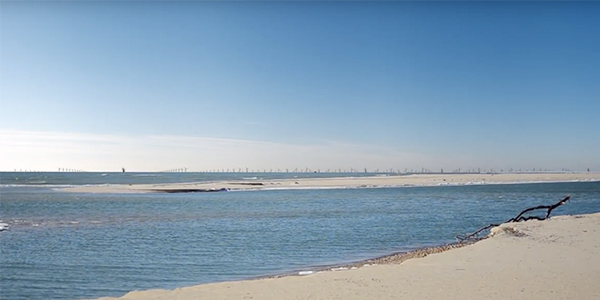By Michael Kuser
Offshore wind in the U.S. hit a new milestone Friday when the eighth federal lease auction brought in $405 million for three sites — about six times the revenue from all previous auctions combined.
Eleven companies participated in 32 rounds of bidding. The winners were Equinor, a Norwegian state-controlled company formerly known as Statoil; Mayflower Wind Energy, a joint venture of Shell and EDP Renewables; and Vineyard Wind, a joint venture by Iberdrola and Copenhagen Infrastructure Partners.
The three lease areas are located 19.8 nautical miles from Martha’s Vineyard and 16.7 nautical miles from Nantucket. The areas total 388,569 acres and, if fully developed, could support 4.1 GW of wind generation, or enough electricity to power about 1.5 million homes.
“Wow … we are truly blown away by this result,” Walter Cruickshank, acting director of the Bureau of Ocean Energy Management, which conducted the auction, said on a press call.
“The intense competition we’ve seen in this offshore wind lease auction is completely unprecedented,” said Nancy Sopko, director of offshore wind for the American Wind Energy Association.
“To anyone who doubted that our ambitious vision for energy dominance would not include renewables, today we put that rumor to rest,” Interior Secretary Ryan Zinke said.
To illustrate the pace of the bidding, a BOEM webpage shows the winning bids — each $135 million — at more than 500 times the size of the opening bids, which started at less than $260,000.
The new industry has gained momentum on the East Coast this year. Massachusetts and Rhode Island in May awarded 1,200 MW of offshore wind energy contracts. Vineyard Wind will supply Massachusetts with 800 MW, while Deepwater Wind won the contract to supply Rhode Island with 400 MW, which Connecticut expanded soon after with a 200-MW award. (See Mass., R.I. Pick 1,200 MW in Offshore Wind Bids.)
New Jersey committed in May to build 3,500 MW, and New York in July authorized procurement of at least 800 MW or more in offshore wind energy, the first part of a two-phase plan to develop 2,400 MW by 2030.
The U.S. Department of Energy in June awarded an $18.5 million grant to the New York State Energy Research and Development Authority to lead a nationwide research and development consortium for the offshore wind industry, with the state to match the federal funds. (See NYPSC: Offshore Wind ‘Ready for Prime Time’.)
Massachusetts officials hope to develop supply chains for the nascent industry in the Port of New Bedford, where they have funded a terminal, but are also working to avoid interfering with fishing operations there, the No. 1 fishing port in the U.S. (See Overheard at ISO-NE Consumer Liaison Group Meeting.)
BOEM said it now has 15 active wind leases for nearly 2 million acres in federal waters.
Before the Dec. 14 lease sale, the highest price for an offshore wind lease was slightly more than $42 million paid by Statoil two years ago for an area in the New York Bight. New York is expected to issue its first offshore request for proposals this month.
The U.S. Department of Justice and Federal Trade Commission will conduct a competitiveness review of the auction, and the provisional winner will be required to pay the winning bid and provide financial assurance to BOEM.
Upon BOEM approval of a site assessment plan in a lease’s first year, the developer then has four and a half years to submit a construction and operations plan (COP).
After the bureau receives a COP, it will conduct an environmental review, with public input, and if BOEM approves the plan, the developer will then have 33 years to build and operate its project.




